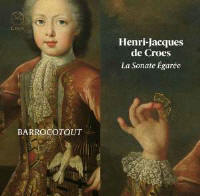Reviewer: Raymond
Tuttle
Here is a rarity.
Henri-Jacques de Croes has appeared in Fanfare only once before, way
back in 1983 when George Chien reviewed an LP that contained a Divertimento
by de Croes and a pair of symphonies by Pierre van Maldere. (Both composers
were associated with Brussels.) De Croes’s dates are 1705–1786, which means
that he was a contemporary of both Leopold Mozart and his slightly more
famous son. De Croes’s writing makes Leopold’s—to say nothing of Wolfgang
Amadeus’s—compositions sound strikingly modern, but that does not diminish
their quality and the craftsmanship displayed therein. These works are not
dull. Speaking of the Mozart, Henri-Jacques should not be confused with his
equally musical son Henri-Joseph, although he is scarcely more familiar than
his father.
The title of this disc alludes not to trio sonatas but to “La
sonate égarée,” which means that these sonatas were lost, except for a copy
located in the music library at the University of Virginia. However, they
were not totally lost, as three of these sonatas already had been published
in the composer’s op. 1 collection of sonatas. Because the op. 1 collection
is almost as obscure—has it been recorded? I do not see evidence of
it—listeners probably will not be bothered or even aware of the duplication.
What is the explanation for de Croes’s conservative style? Don’t
blame his employer. Linn’s booklet contains a generous biographical note by
Miel Pieters, who explains that de Croes was maître de chapelle for
Charles of Lorraine, Governor of the Austrian Netherlands. Charles’s musical
tastes were more progressive than those of his successor, so de Croes was
encouraged to move away from the Baroque style in favor of the more modern
style galant. One explanation for de Croes’s style appears to
have been his association with Brussels, which was not a hub of musical
innovation during the 1700s. (That said, Italian influences can be heard in
these trio sonatas.) Furthermore, he does not appear to have traveled
extensively. On the other hand, Henri-Joseph eventually secured a position
in Regensburg with the house of Thurn and Taxis, where there was an
excellent orchestra, and he showed little interest in succeeding his father
in Brussels. In fact, Henri-Joseph’s marriage, in 1777, to a prominent
singer strained the limited finances of his father, who consequently had to
sell many of his works to Charles of Lorraine himself.
While not revolutionary, these six trio sonatas are more than simply
pleasant. They are sunny (even when they are in a minor key) and vigorous,
and probably fun to play, given the composer’s penchant for what might be
called busy (but not gratuitously so) part writing. They also demonstrate
the composer’s mastery of how to compose for the flute, although the violin
was his interest. De Croes might be largely forgotten, but it is not because
he wrote dull or unimaginative music.
The members of BarrocoTout are Carlota Garcia (traverso), Izana Soria
(violin), Eduardo Catalan (cello), and Ganaël Schneider (harpsichord). These
are bright and alert performances that suit the music well, and the playing
is tonally refined. Listen, for example, to Garcia and Soria in the central
Adagio of the Trio Sonata No. 2, and you can’t fail to notice the
grace and sensitivity of their dialogue with each other. All goes well in
these readings, with no rushing or pushing.
Linn’s engineering is, as expected, outstanding. The instruments have a
strong, realistic presence, and are optimally in balance. You can almost
reach out and touch the harpsichord.
Perhaps
this is not an essential purchase, but it will be appreciated by those with
tastes for music from either the late Baroque or Rococo periods.
Fermer la fenêtre/Close window |




